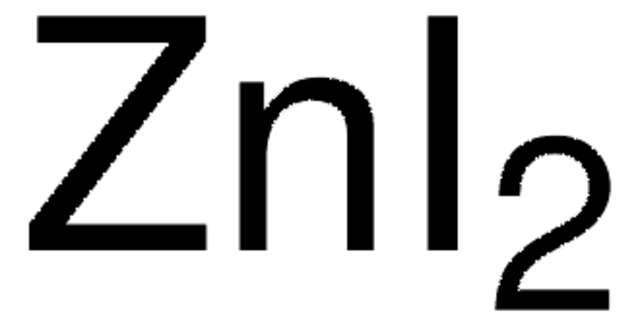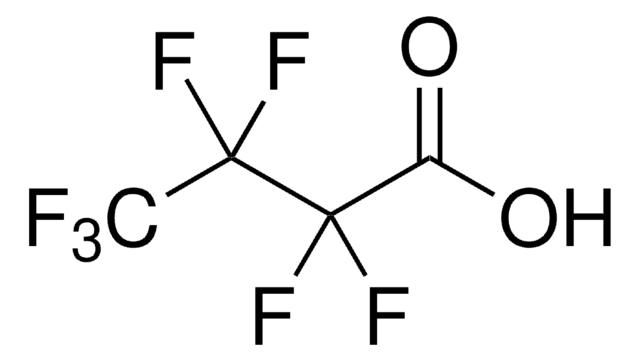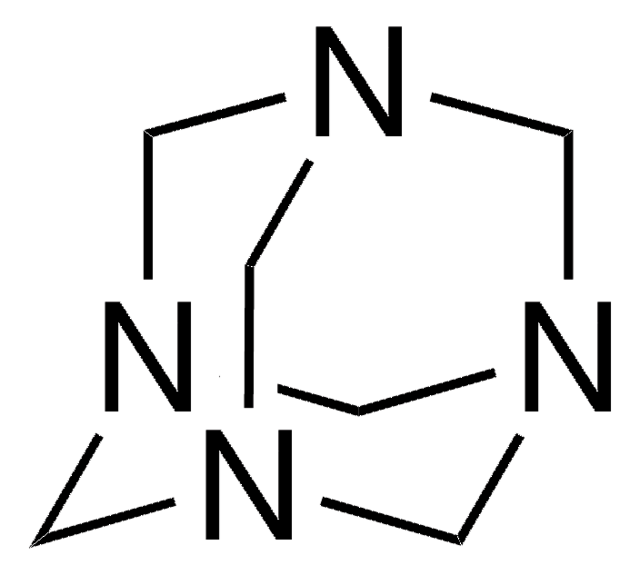Kluczowe dokumenty
96483
Zinc iodide
purum p.a., ≥98.0% (AT)
Synonim(y):
Diiodozinc, Zinc diiodide
About This Item
Polecane produkty
klasa czystości
purum p.a.
Poziom jakości
Próba
≥98.0% (AT)
Formularz
powder or crystals
mp
445 °C (lit.)
gęstość
4.74 g/mL at 25 °C (lit.)
ślady anionów
sulfate (SO42-): ≤500 mg/kg
ślady kationów
Ca: ≤500 mg/kg
Cd: ≤200 mg/kg
Co: ≤50 mg/kg
Cu: ≤50 mg/kg
Fe: ≤100 mg/kg
K: ≤500 mg/kg
Na: ≤500 mg/kg
Ni: ≤50 mg/kg
Pb: ≤50 mg/kg
ciąg SMILES
I[Zn]I
InChI
1S/2HI.Zn/h2*1H;/q;;+2/p-2
Klucz InChI
UAYWVJHJZHQCIE-UHFFFAOYSA-L
Szukasz podobnych produktów? Odwiedź Przewodnik dotyczący porównywania produktów
Powiązane kategorie
Opis ogólny
Zastosowanie
- As a catalyst for one-pot synthesis of aminoindolizines via sequential A3 coupling/cycloisomerization.
- As a catalyst for one-pot synthesis of quinoxalines.
- As a precursor to synthesize highly luminescent quantum dots.
- As a redox electrolyte in hybrid energy storage systems.
- As a dopant to prepare highly flexible PVA composite films. The addition of zinc iodide enhances the optoelectronic properties of polymer composite.
Hasło ostrzegawcze
Warning
Zwroty wskazujące rodzaj zagrożenia
Zwroty wskazujące środki ostrożności
Klasyfikacja zagrożeń
Aquatic Acute 1 - Aquatic Chronic 1 - Eye Irrit. 2 - Skin Irrit. 2
Kod klasy składowania
11 - Combustible Solids
Klasa zagrożenia wodnego (WGK)
WGK 3
Środki ochrony indywidualnej
Eyeshields, Faceshields, Gloves, type P3 (EN 143) respirator cartridges
Wybierz jedną z najnowszych wersji:
Masz już ten produkt?
Dokumenty związane z niedawno zakupionymi produktami zostały zamieszczone w Bibliotece dokumentów.
Nasz zespół naukowców ma doświadczenie we wszystkich obszarach badań, w tym w naukach przyrodniczych, materiałoznawstwie, syntezie chemicznej, chromatografii, analityce i wielu innych dziedzinach.
Skontaktuj się z zespołem ds. pomocy technicznej







